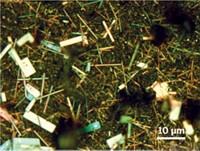Advertisement
Grab your lab coat. Let's get started
Welcome!
Welcome!
Create an account below to get 6 C&EN articles per month, receive newsletters and more - all free.
It seems this is your first time logging in online. Please enter the following information to continue.
As an ACS member you automatically get access to this site. All we need is few more details to create your reading experience.
Not you? Sign in with a different account.
Not you? Sign in with a different account.
ERROR 1
ERROR 1
ERROR 2
ERROR 2
ERROR 2
ERROR 2
ERROR 2
Password and Confirm password must match.
If you have an ACS member number, please enter it here so we can link this account to your membership. (optional)
ERROR 2
ACS values your privacy. By submitting your information, you are gaining access to C&EN and subscribing to our weekly newsletter. We use the information you provide to make your reading experience better, and we will never sell your data to third party members.
Materials
Perovskites Emit Laser Light
Materials: The inexpensive and efficient photovoltaic materials may find another use in light-emitting devices
by Prachi Patel
April 17, 2014
| A version of this story appeared in
Volume 92, Issue 16

Perovskites, materials known to be inexpensive and efficient at converting light to electricity, also can be used to make lasers. Researchers have demonstrated that a perovskite can convert 70% of absorbed light into emitted light (J. Phys. Chem. Lett. 2014, DOI: 10.1021/jz5005285). This remarkably high luminescent efficiency is critical for light-emitting devices.
The advance points to the possibility of cheap lasers that could be used in many applications, such as communications, manufacturing, and consumer electronics, says Henry J. Snaith, a physicist at Oxford University who has pioneered work in perovskite solar cells.
Perovskites, a large class of crystalline materials, combine the best features of two major types of photovoltaic materials. Like silicon, they have high light-to-electricity conversion efficiencies. Yet they are inexpensive and easy to prepare in solution, just like organic photovoltaic materials.
In March, scientists from Switzerland and Singapore reported laser-light emission from perovskite crystals consisting of two-dimensional layers of metal halides separated by organic materials (Nat. Mater. 2014, DOI: 10.1038/nmat3911).
In the new study, Snaith, Richard H. Friend at Cambridge University, and their colleagues tested the lasing abilities of the perovskite CH3NH3PbI3-xClx, a 3-D crystal. The 3-D structure makes it a better semiconductor, making it more suitable for light-emitting devices, Snaith says.
The researchers deposited a thin film of the perovskite onto a glass surface and then measured its luminescent efficiency—the ratio of photons emitted to photons absorbed. They found that when the material absorbs light, it generates electrons and positively charged vacancies in the crystals called holes. “Electrons and holes recombine either by emitting light or through a nonradiative decay pathway, like heat,” Snaith explains. Nonradiative decay can occur at defects in the crystal. The researchers speculate that because the crystal has very few defects, effectively 70% of the electron-hole pairs formed recombine to produce photons, resulting in the material’s high luminescent efficiency.
To make a laser, the researchers placed the perovskite film into a cavity that could bounce light back and forth to produce laser light. When excited with 0.4-nanosecond pulses of green laser light at a high enough intensity, the laser emits near-infrared light with a wavelength around 760 nm.
Snaith says that they can easily tune the produced light from IR to ultraviolet wavelengths. To make light-emitting diodes, he says, they will need to find a way to excite the materials electrically.
Yang Yang, a materials scientist at the University of California, Los Angeles, says that because high luminescent efficiency corresponds to high light-to-electricity conversion efficiency, these materials could lead to thin-film photovoltaic devices that are “the dream of the solar-cell community.” The new work “shows a bright future for perovskites in solar-cell and LED applications,” he says.





Join the conversation
Contact the reporter
Submit a Letter to the Editor for publication
Engage with us on Twitter